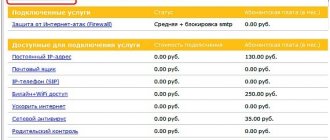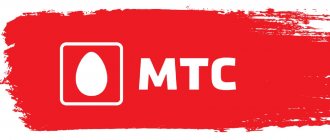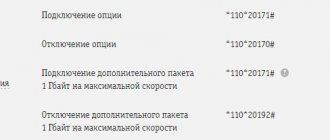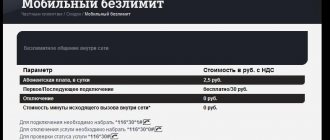Motive Network
Motive has its own characteristics, partly related, first of all, to technology. Because let’s note right away that all marketing techniques are the same as those of MTS and Megafon. And very soon we will see routers, smartphones and tablets with LTE support under the Motiva brand.
So let's talk about technical details.
Motiv, unlike competitors who launched LTE earlier, has only one frequency range at its disposal, namely 1800 MHz. Therefore, the operator had to divide his range into two unequal parts. As Konstantin Bryzgalov, deputy development director of the Motiv company, said, in Yekaterinburg, out of the 15 MHz that are available, 5 MHz were given to 4G. In other cities, fourth-generation communications took a little more, because there is less voice traffic.
The Ural cellular operator, of course, plans to transfer voice to LTE, but this is in the distant future. When the Motive network is completely modernized.
What conditions does the operator offer?
As already mentioned, the Motiv operator offers its subscribers a lot of options for using communication services. There are both comprehensive solutions and options without a fixed monthly fee. But they all need to be considered in more detail.
Comprehensive packages
Initially, it is worth considering tariff plans from the budget series “Instead!” There are only 5 such offers. Each of them contains established sets of options and differs in cost in accordance with the volume of capabilities.
The amount of the subscription fee is determined by the name of the tariff:
- “For 300” – the package contains 4.5 GB of Internet traffic. The subscription fee is 300 rubles.
- “For 600” – the user receives 15 GB of Internet traffic and 100 unpaid minutes for long-distance calls.
- “For 900” - for Internet surfing, subscribers are provided with 30 GB of traffic, at night there is a complete unlimited access to the Internet. 200 minutes are allocated for long-distance calls.
- “For 1200” – the size of the allocated Internet traffic is 50 GB, completely unlimited at night. 300 minutes are allocated for long-distance communication.
- “For 1800” – users receive 100 GB of traffic for daytime surfing; at night, absolutely unlimited. 400 bonus minutes are provided for long-distance communication.
Calls to Motiv network subscribers are not charged, as are calls to other numbers in your home area. Communication with numbers in other regions will cost subscribers 2.5 rubles. for every minute. Internet traffic from social networks is also not subject to tariffs, but only starting from the “Over 600” package.
About problems
As Motiv explains, even with a partial transition to 4G, any operator will face a number of problems. And the first and most important thing here is the throughput of the transport network. Motiv has both its own and leased communication lines between cities. The equipment on them was designed for traffic volumes sufficient for voice transmission, but not Internet traffic. The thing is that Motive never had 3G. The operator immediately jumped to 4G from 2G. Therefore, we had to actively modernize transport networks.
The second problem is base stations. In addition to the fact that they need to be purchased and installed, there is another difficulty with them. If base stations operating in LTE have overlapping coverage areas, then the likelihood of interference is high. This is a problem, of course, that can be solved especially taking into account the fact that when operating in the 1800 MHz band, too high a density of base stations is not required (which, by the way, Motiv did not forget to boast about).
And the third problem, already mentioned above, is the frequency range. That is, this becomes a problem when the user device says that it supports LTE. The operator claims that it has LTE. But the ranges don't match. This, for example, happened with the iPhone 5, which at first did not work at all in the bands of Russian LTE operators. Although, Apple subsequently released updates, thanks to which the devices of this manufacturer began to support LTE in all bands.
Samsung also had problems. Representatives of this company arrived quite late to certify the Motiv network. Certified. Then they started writing software updates so that the phones would work in the LTE network of the Ural operator, and this process dragged on. As a result, it turned out that not all 4G smartphones from this manufacturer immediately began working on Motiv’s fourth-generation network.
The mobile operator did not have such problems with other manufacturers, but, nevertheless, the two above-mentioned brands are among the most purchased.
How to check your connection speed
First measure your current network speed. If you have Android, turn on the display of the indicator in the settings and watch it:
- Expand the phone settings menu.
- Go to Notification Center or Notification Settings.
In settings, expand the section dedicated to notifications
Tap on the last item “Advanced settings”
Highlight the "Display current network speed" option
You can find out the speed using special applications. One of the popular ones is Speedtest.net:
- Download the utility to your phone via the market.
- Open it and tap on .
Start a speed test in the program interface
We are waiting for the verification to complete
Evaluate the result of the speed test in the application
A speed of 1 MB/s is enough for communicating on social networks and launching websites, but this indicator is no longer enough for watching videos. Connect to Wi-Fi if possible. If pages load just as slowly, most likely the problem is with the phone (incorrect settings, clogged application cache). If it's the other way around, then in the operator.
Test Drive
Immediately after the launch of the network, Motiv began providing LTE for free as part of a promotion, and collecting feedback from subscribers who decided to try fourth-generation communications. In just six weeks, 13,000 people from several Ural cities took part in testing.
The traffic turned out like this:
The distribution by region is quite interesting. The absolute leader in consumption per subscriber per day is the Yamalo-Nenets Autonomous Okrug. That is, where wired Internet is bad, people consume almost three times more mobile traffic than in regions where there is normal broadband access.
Naturally, the volume of consumed traffic in general has also increased.
Today, Motiv has 4G communications available to 3 million people—that’s 41% of the population of the Sverdlovsk and Kurgan regions, Yugra, and Yamal. And by the end of 2015 they plan to make their 4th generation network available to 80% of the population in these regions.
For iOS and Windows Phone
The general configuration algorithm is the same for all mobile devices; only the values required to enter differ.
To configure a gadget running on an Apple operating system (for example, an iPhone or iPad), you must perform the following operations:
- Through the main menu of the device, go to the settings settings.
- Go to the cellular communications section.
- Find the network and data transmission subsection and go to it.
- Create a new APN connection.
- The Motive 4G access point has the parameters described for the Android OS.
And for dessert, a little more about saving battery power
One of the problems that owners of gadgets connected to LTE have encountered is energy consumption. The average LTE smartphone's battery will drain within a few hours if you actively use the Internet. In this regard, Motiv plans to start using technology that allows users to save energy on LTE devices.
The technology is called DRX/DTX (DRX - intermittent reception mode, DTX - intermittent transmission mode). It allows you to save energy by activating the subscriber device only during those periods when it must receive the signal transmitted by the base station. At the same time, the smartphone (tablet, 4G modem) is mainly in standby mode, which allows you to save battery power.
Specifications
How to update traffic and increase Internet speed on Motive
At the moment, two modems are available: TS-UM6602 for 2,290 rubles and TS-UM6605 with Wi-Fi for 2,690 rubles. Their characteristics are almost identical:
- support for 2G EDGE and GPRS standards at a frequency of 1,800 MHz;
- support for 4G LTE standard at 1,800 MHz;
- ability to connect microSD cards up to 32 GB;
- compatible with Windows operating systems (XP and higher) and MAC OS (10.10);
- availability of storage mode thanks to the ability to connect a microSD card;
- connection to the network via a USB interface in modem mode.
Important! A distinctive feature of the more expensive TS-UM6605 device is support for Wi-Fi communications according to 802.11 b/g/n standards. This is a kind of plug-in Wi-Fi adapter.
Third with LTE
What do we have? We have a third operator in the Urals with LTE, and tariffs are approximately the same as those of competitors. And in other aspects, Motive is following in the footsteps of MTS and Megafon, planning to sell inexpensive branded equipment with LTE, and launching an advertising campaign with slogans on the theme of speed.
Actually, the whole difference between Motive and the Big Three operators is that Motive did not have extra frequencies that could be used for LTE. On the one hand, this complicated the operator’s work, since it had to divide its range into 2G and 4G. On the other hand, this allowed saving on the installation of base stations. Because in the 1800 MHz band, which Motiv had, LTE base stations have a longer range than in competitors’ bands.
At the same time, in terms of mobile Internet speed, Motiv, judging by statements from representatives of the company itself, loses to both MTS and Megafon. Let it be problematic for the user to distinguish 10 Mbit/s from, for example, 30 Mbit/s. Here, of course, what is more important is not who has the fastest Internet, but who has better advertisers. The same applies to technology that will save smartphone battery power. It sounds great, of course, but this needs to be conveyed to potential subscribers (not to mention implemented).
As a result, an obvious prediction arises: Motiv with its LTE will not explode the market, but it will hit its competitors.
Why is the internet on my phone slow?
What causes mobile Internet speed to decrease:
- Problems on the operator's side - perhaps technical work is being carried out.
- Weak coverage area - the phone is located far from the tower. If possible, check out the operator's coverage map in your city (go to its official website) and change your location.
Look at the coverage map to see which zone you are currently in.
Stop auto-updating apps











